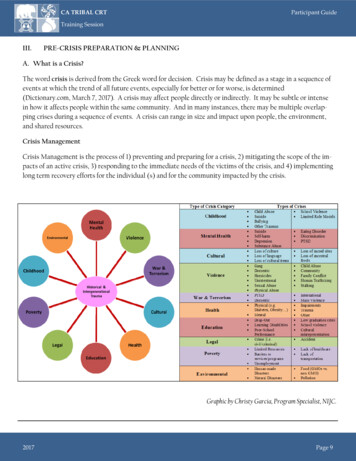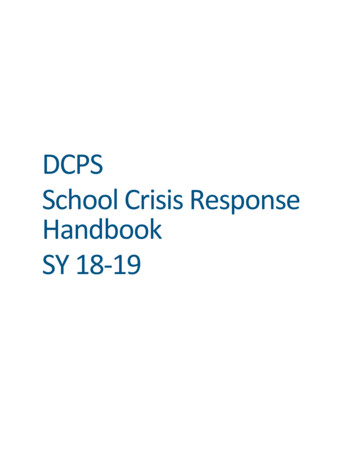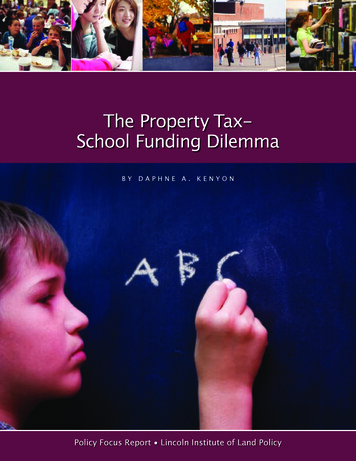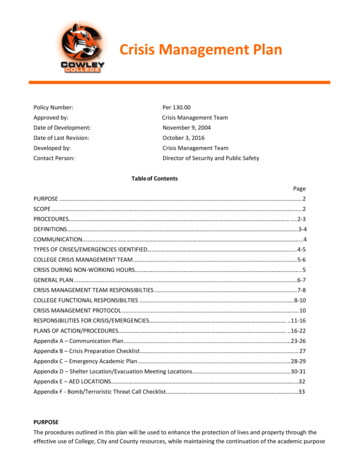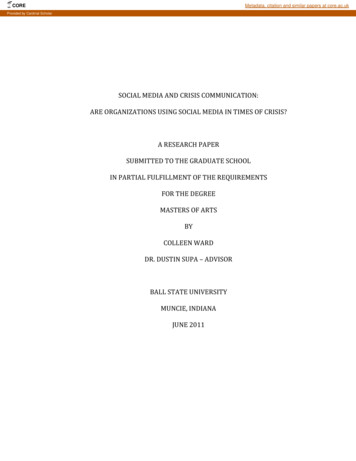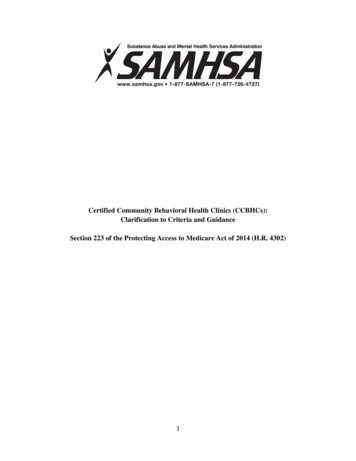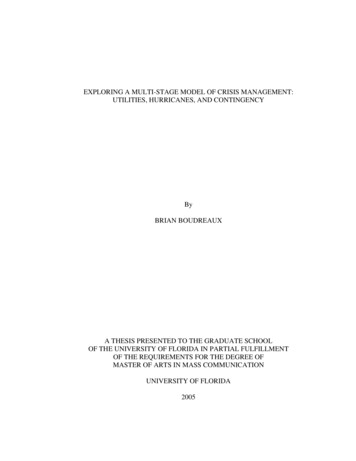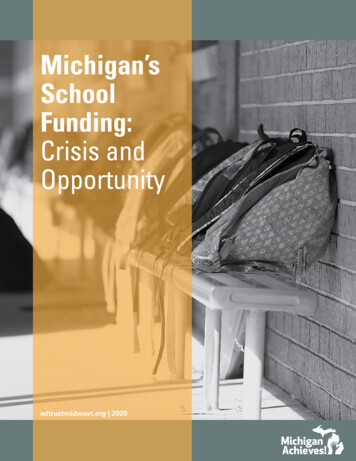
Transcription
Michigan’sSchoolFunding:Crisis andOpportunityedtrustmidwest.org 2020
IntroductionBy Amber ArellanoExecutive Director, The Education Trust-MidwestOver the last decade, The Education Trust-Midwest (ETM) has been leading a major campaignto make Michigan a top ten education state for teaching and learning and educationalperformance for all groups of students, no matter who they are or where they live. TheMichigan Achieves! Campaign has been hugely successful in many respects. In partnershipwith many public leaders, organizations and stakeholders, our organization has taken boldaction, leading to policy change; effective coalitions; major new strategies and investments in criticallyneeded levers for improvement such as third-grade reading; and new civic infrastructure designed tobuild educators’, parents’, policymakers’ and other stakeholders’ capacity to play a role in improvementefforts for all students to succeed. And we have inspired many others to take action, too.The need for this campaign has arguably never been greater. Michigan ranks sixth from the bottom inimprovement for 4th grade math among all students from 2003 to 2019, according to recently releaseddata from the 2019 National Assessment of Educational Progress (NAEP). Compared to other states,Michigan ranks fifteenth from the bottom for improvement in 4th grade reading from 2003 to 2019,according to the NAEP, also known as the Nation’s Report Card. With such low rates of improvement, itwill be difficult for Michigan to reach its top ten goals for both educational progress and performance.Gaps in achievement and opportunity continue to be stark between students in the state, as well.Average scores for low-income, Latino and Black students in Michigan are lower than their higherincome and White peers, according to the national assessment, and Michigan falls below the nationalaverage for low-income and Black students in 4th grade reading and 8th grade math.Never before, though, has our organization focused so deeply on school funding as we do in this newreport, Michigan’s School Funding: Crisis and Opportunity. And that has been for good reason: moneyalone is insufficient for educational transformation, as leading education states demonstrate. As a datadriven, research-based policy, research, advocacy and technical assistance organization, we follow the2INTRODUCTION
data. And the data tell us that many factors — not simply money — are important for driving dramaticimprovement in student learning outcomes, especially for low-income students and children of color.Yet money matters. And that, too, is clear based on research. Money especially matters for studentsfrom low-income backgrounds. Increases in spending have been shown to improve educationalattainment, lead to higher wages and reduce poverty in adulthood, particularly for students fromlow-income backgrounds.1 By one estimate, the lifetime earnings of Michigan’s current K-12 studentscould increase by 27 billion if their educational achievement matched the national average.2 In astate that is rebuilding and transitioning its economy and tax base from a manufacturing-based,old economy model to a robust knowledge-based economy, there is perhaps no more importantinvestment to make to ensure our Great Lakes State becomes a Great Education and Great EconomyState — and catches up with therest of the nation and the world botheconomically and for talent.““By one estimate, thelifetime earnings ofMichigan’s currentK-12 students couldincrease by 27 billionif their educationalachievement matchedthe national average.”It’s also increasingly clear Michigan’shigh-poverty public schools anddistricts do not have the resourcesthey need to educate and supporttheir students to learn at high levels.A recent report from the EducationLaw Center gave Michigan a “D”for how well it targets funding to itshigh-poverty districts, relative to itslow-poverty districts.3 Similarly, ananalysis by The Education Trust —our organization’s respected nationaldivision — found that Michiganranks in the bottom five statesnationally for funding gaps that negatively impact students from low-income families.4 Michigan’sfunding of special education is also highly underfunded as special education services are often timespartially funded with dollars intended for all students.5 Despite Michigan having one of the highestrates of concentrated poverty in the country,6 the state’s current funding system does not providefunding specifically for districts with high concentrations of students from low-income backgrounds.What’s more, Michigan is one of only 16 states providing less funding to its highest-poverty districtsthan to its lowest-poverty districts.73MICHIGAN’S SCHOOL FUNDING: CRISIS AND OPPORTUNITY
Michigan’s funding system is not only unfair and deeply inequitable; it’s also inadequate. Michigan’ssystem of school funding is, simply put, not designed to keep pace with the costs and realities ofmodern U.S. educational systems today. A report from Michigan State University (MSU) found thatbetween 1995 and 2015, Michigan had the lowest total education revenue growth of all 50 states.8MSU researchers found when adjusted for inflation, Michigan’s per-pupil funding declined by 22 percentbetween 2002 and 2015.9As the public dialogue about school funding has grown in the state, much of the conversation has beenfocused on adequacy. Yet fairness and equity in school funding also are central to the vital conversationabout the state’s future — and the future of thousands of low-income and other vulnerable students,whether they live in the Upper Peninsula or the shores of West Michigan, Pinconning or Pontiac, Warrenor Wyoming. Indeed, Michigan’s education crisis provides a rare historic opportunity to make the systemmore fair and equitable and to overcome decades of historic inequities.It’s clear Michigan needs to investmuch more in all of its studentsstatewide, while investingsignificantly more in the studentswho need it most whom we highlightin this report.““It’s clear Michiganneeds to invest muchmore in all of itsstudents statewide,while investingsignificantly morein the students whoneed it most whom wehighlight in this report.”More than a year ago, Ed TrustMidwest partnered with nationalorganizations including our ownnational office to dig deeper intoMichigan’s funding system andproposals to improve it. We are gladto share this report with the goal ofproviding stakeholders with a set ofnonpartisan, research-based guidingprinciples which Michigan leaders,policymakers, families, educators andother stakeholders may use to evaluate funding systems and proposals. This report also shares analysesof the current funding system and how well it is structured to serve Michigan’s students, schools anddistricts — particularly vulnerable student groups and high-poverty schools — and provides importantnonpartisan recommendations for Michigan at a crucial time in its history and the future of the state’spublic school system. Finally, we highlight lessons learned from states around the country — including4INTRODUCTION
the nation’s leading education states — to inform the policy conversation in Michigan.Indeed, the lessons learned from other states around the country are critical. Much important work hasbeen done on equitable funding in other states for decades, as well as in recent years. Long heraldedas one of the nation’s leading education states for performance for all students, recently Massachusettsleaders passed legislation that commits to significantly increasing state investment in the highest-needdistricts in coming years. In fact, when the law is fully implemented, the Commonwealth’s highestpoverty districts will be expected to — and receive state support to — spend about 100 percent moreper low-income student than per non-low-income student. Importantly, the legislation also requiresall districts to take steps to address disparities in opportunity and achievement between historicallyunderserved student groups and more privileged students. A model for Michigan, it’s also takenlandmark steps for the state to close the funding gap between districts by investing more state dollarsinto high-poverty, low tax base districts.As with any policy change, the states leading work on equitable school funding show that greatintentionality and caution are needed when exploring and making such reforms. In California, forexample, some positive gains have been made yet there have also been consequences, which new dataand a growing number of leaders say are harmful for vulnerable children, in particular.10Michigan faces a unique opportunity as it faces a real school funding crisis in the state. If done right, anoverhaul of its funding system would provide state leaders and stakeholders with a major opportunity tomake the funding system adequate and equitable.We hope you’ll join our growing efforts across the state to make Michigan a top ten state for allstudents — no matter who they are or their background. Visit michiganachieves.com/take-action to getmore information about events and other opportunities to get involved.To all of the Michigan educators, parents, partners and stakeholders who are working tirelessly tosupport children’s teaching and learning, many thanks! We appreciate you and we stand by yourefforts.Onward,Amber ArellanoExecutive DirectorThe Education Trust-Midwest5MICHIGAN’S SCHOOL FUNDING: CRISIS AND OPPORTUNITY
Summary: Principles for Fair and EquitableFunding Systems or Proposals1 Provide funding according to student need.Provide at least 100 percent more funding for students from low-income backgrounds.Provide at least 75 to 100 percent more funding for English learners (ELs).Provide additional funding to support students with disabilities.Provide the full amount of additional funding for every category of need that students meet.Target resources to high-poverty districts and schools.2Provide more funding to districts with lower fiscal capacity. Provide equalization funding to low-wealth districts. Provide additional funding for rural and sparse districts.3Ensure dollars are used well to improve student experienceand outcomes. Require districts to spend according to student need. Require districts to develop and publish a plan for how they will use funding.4Be transparent about the system’s design and monitor funding districtsactually receive. Annually publish information about how the funding system is designed to work in clear, plain-language. Publish easy-to-follow data on the amount of funding each district should receive according to the state fundingsystem, compared to what it actually receives. Review the funding system to understand patterns in which districts are being underfunded.5Provide transparent data on funding going to schools. Develop, use and publish consistent rules for calculating spending for all schools in the state. Report clear, timely and accessible school and district spending data alongside contextual information to enableequity-focused comparisons.6SECTION TITLE
Executive SummaryMichigan’s public education system is facing a crisis by many important measures.Compared to other U.S. states, Michigan ranks sixth from the bottom for educationalimprovement in 4th grade math among all students between 2003 to 2019, accordingto recently released data from the 2019 National Assessment of Educational Progress(NAEP). Michigan ranks fifteenth from the bottom for improvement in 4th grade readingfrom 2003 to 2019, according to the NAEP, also known as the Nation’s Report Card. If Michigan publicschools continue to produce such low rates of improvement, it will be difficult for Michigan to reachits goal of becoming a top ten education state for learning outcomes. In addition, gaps in achievementcontinue to be stark between groups of students in the state. Average NAEP scores for low-income, Latinoand Black students in Michigan are lower than their higher-income and White peers, and Michigan fallsbelow the national average for low-income and Black students in 4th grade reading and 8th grade math.The state’s crisis is not isolated to student learning outcomes, however. A report from Michigan StateUniversity found that between 1995 and 2015, Michigan had the lowest total education revenue growthof all 50 states.11 MSU researchers found when adjusted for inflation, Michigan’s per-pupil fundingdeclined by 22 percent between 2002 and 2015.12The impact of the state’s relative lack of investment arguably has been felt most by Michigan’smost vulnerable children, schools and districts. A recent report from the Education Law Center gaveMichigan a “D” for how well it targets funding to its high-poverty districts, relative to its low-povertydistricts.13 Similarly, an analysis by The Education Trust — the Education Trust-Midwest’s respectednational division — found that Michigan ranks in the bottom five states nationally for funding gaps thatnegatively impact students from low-income families.14 Michigan’s funding of special education is alsohighly underfunded as special education services are often times partially funded with dollars intendedfor all students.157MICHIGAN’S SCHOOL FUNDING: CRISIS AND OPPORTUNITY
It’s clear Michigan needs to investmuch more in all of its studentsstatewide, while investingsignificantly more in the studentswho need it most whom we highlightin this report.““Equity is not the onlyfocus of the report,but a central one forgood reason: fundinginequities contribute tomajor gaps in learningopportunities forstudents from differentcommunities andbackgrounds.”The good news, many leaders andorganizations are taking an interestin improving Michigan’s publiceducation funding system. GovernorGretchen Whitmer is among theleaders who have identified thispolicy issue as a central one to thestate’s future. More recently, LaunchMichigan — a new collaborative oforganizations anchored by Michigan’sbusiness, K-12 and philanthropiccommunities of which The EducationTrust-Midwest organization is part — released recommendations in December which highlighted theneed for a more equitable school funding system in the state.16Given the critical importance of this issue to Michigan’s students, educators and other stakeholders,our organizations brought together their expertise to produce this report: The Education Trust, a leadingnational education nonprofit, which has more than two decades of expertise in equitable educationalresources and outcomes, and The Education Trust-Midwest, a nonpartisan research, policy andadvocacy organization with a decade of expertise in Michigan education policy. We consulted with twoleading national organizations with deep expertise in the area of equitable school funding and statefunding systems, whom we gratefully acknowledge in the Appreciations section of this report.This report outlines a set of nonpartisan, research-informed guiding principles and a framework forpolicymakers, families, educators, community leaders and other stakeholders to evaluate the state’scurrent funding system. It also analyzes Michigan’s current funding system and how well it is structuredto serve Michigan students, schools and districts — particularly vulnerable student groups and highpoverty schools. It also provides nonpartisan recommendations — and guideposts — for Michigan at acrucial time for the state’s public school system. Finally, it highlights lessons learned from states aroundthe country — including the nation’s leading states on equitable school funding — to inform the policy8SECTION TITLEEXECUTIVESUMMARY
conversation about school funding reform in Michigan.The following questions undergird most conversations about state funding formulas, and are criticalfor Michigan to consider when designing or changing its school funding system. While all of thesequestions are important, this report focuses on the three questions most critical for advancing theinterests of our most historically underserved students: equity, transparency and accountability. Is the system allocating adequate funding to provide a high-quality education? Is the system equitable, and does it prioritize funding that truly addresses all students’ needs? Is the system predictable and stable so district leaders can anticipate funding levels from oneyear to the next, enabling thoughtful multi-year planning processes? Is the system flexible to allow district leaders to operate school systems in the ways thatwork best for their local context (while also ensuring that the students with greatest needs areprioritized within districts)? Is the system transparent to allow stakeholders to understand whether dollars targeted forstudents who experience vulnerabilities actually reach them? Is the system designed with levers for monitoring and accountability for the effectivenessof the state’s investments to ensure vulnerable children are actually being reached and wellserved by greater investment?As we outline in this report, there are specific actions stakeholders in Michigan can and should take tofully embed these ideals in the state’s funding system.Starting on page 16, we outline a set of equitable funding principles — which are informed by researchand national best practices — and we provide corresponding criteria for evaluating how effectively anystate funding system or proposal adheres to these principles.Please see the Appendix on pages 46-47 for more information and background on this topic.Beginning on page 17, we evaluate the current Michigan funding system against these principles andprovide recommendations for Michigan to improve equity in its funding system.Equity is not the only focus of the report, but a central one for good reason: funding inequities contributeto major gaps in learning opportunities for students from different communities and backgrounds.State and local funding allocations can have major impacts on the learning conditions in each district,including the availability of student support and extracurricular activities, the amount of instructional9MICHIGAN’S SCHOOL FUNDING: CRISIS AND OPPORTUNITY
time, the quality of instructional materials, the level of professional support and compensation teachersreceive, and much more. Specifically, increases in spending have been shown to improve educationalattainment, lead to higher wages and reduce poverty in adulthood, particularly for students from lowincome backgrounds.17 By one estimate, if the student achievement of Michigan’s current K-12 studentsmatched the national average, this could represent over 27 billion greater lifetime earnings for thesestudents.18Michigan faces a unique opportunity as it addresses a real school funding crisis in the state. Anoverhaul in its funding system would provide state leaders and stakeholders with a major opportunityto make the funding system adequate and equitable — and to overcome decades of historic inequitiesthat have had harmful impacts on vulnerable students across every geographic area of the state. If doneright, an equitable funding system could have dramatic benefits for all Michigan stakeholders, fromstudents to parents, to educators and the state’s economy. If properly invested and utilized, studentswould be better equipped through better trained teachers, high-quality instructional materials andneeded supports that can help a struggling student excel.Through the guiding principles and policy priorities described through this report, Michigan can begintaking steps in the right direction to provide more fair funding to Michigan schools and a far brighterfuture for Michigan students and their public schools.Guiding policy principles for improving Michigan’s funding system include:1. Provide funding according to student need.Researchers estimate that funding systems should provide at least 100 percent more funding forstudents from low-income backgrounds than for students from higher income backgrounds.19 Studentsin Michigan from low-income backgrounds are supported by an additional 11.5 percent of the statewideaverage foundation allowance,20 which, in FY20, was about 960 in additional funds per eligiblestudent.21 That 11.5 percent is well below what is recommended by research to close opportunitygaps.22Other student groups also have additional needs for greater investment and support, whether a studentis an English learner, has a disability or faces another major barrier to learning, such as attendinga geographically isolated public school. These students are found across the state, no matter if thecommunity and school district is an urban, rural, working class or suburban one.Consider Burt Township School District, located on the shores of Lake Superior in Michigan’s UpperPeninsula. The small school district of about 30 students is rural, isolated and 70 percent low income.2310EXECUTIVE SUMMARY
Consolidation with another school district is not a viable option, as the nearest neighboring districtis more than 50 miles away in an area that receives an average snowfall of 148 inches.24 Achievingequity in educational opportunity is far more difficult in a community like Burt Township because of itsdemographics and geography, yet the need for its students to receive an excellent education is just asgreat as anywhere else in the state.Or take Wyoming Public Schools, where almost one in every five students is an English learner –students with limited Englishproficiency.25 In addition to the typicalcourse of study, these students alsomust learn a new language, requiringsignificantly more assistance andsupport than a student who isa native English speaker. Thesesupports and instruction deserveand need adequate investment to bedone well.““An overhaul in itsfunding system wouldprovide state leadersand stakeholders witha major opportunityto make the fundingsystem adequate andequitable — and toovercome decades ofhistoric inequities”Finally, consider Michigan’s fundingof special education, which also ishighly inequitable and inadequate.26State (and federal) lawmakershave shifted most of the fundingresponsibility to the local and countylevels, yet Michigan’s fundingstructure precludes local districtsfrom levying taxes to cover additional special education costs. Under federal law, public school districtsare required to provide a “free appropriate public education” to students with disabilities, in theleast restrictive environment. Meeting the needs of students with disabilities is both important andexpensive. A Michigan State University study found that, in order to fully fund special education costs,Michigan districts use more than 500 per pupil from general education funds, on average.27 This evenexceeds 1,000 per pupil in some districts. This affects both special education and general educationstudents because diverting general education dollars to cover the needs and requirements of specialeducation dollars leaves fewer dollars for pupils overall.2811MICHIGAN’S SCHOOL FUNDING: CRISIS AND OPPORTUNITY
2. Provide more funding to districts with lower fiscal capacity.Michigan’s current funding formula specifies the state will carry a larger share of education fundingburden for districts with lower fiscal capacity. It is critical that the state take steps to fully implementthis commitment. State equalization funding — meaning the state provides more dollars to lowwealth districts to close the gap between local revenue and the cost of meeting students’ needs — isimportant to counteract local funding inequities. State equalization funding is also particularly importantto ensure that schools and districts serving the most students from low-income backgrounds and otherhistorically underserved backgrounds are not shortchanged.As this report outlines, Michigan does provide state equalization funding but there is major roomfor improvement. Over time, Michigan should move to a single, per student funding target that isconsistent across every district while also ensuring of funding stability and adequacy for all districts.Massachusetts provides a model for Michigan for this type of approach toward building a much moreequitable funding system, as we highlight in the body of this report.3. Ensure dollars are used well to improve student experience and outcomes.Having the appropriate resources is necessary, but alone it is not enough. To improve student learningand outcomes, those resources must also be spent efficiently and effectively to drive improved learningoutcomes.An important first step toward more equitable student funding in Michigan is directing any newadditional resources first towards high-needs schools and districts. The state must also ensure that thenecessary legal and regulatory frameworks are in place to ensure these additional dollars get to theschools where vulnerable students attend and are spent in ways that improve classroom learning. Stateefforts to provide additional funding to support such students will have limited impact if the funds arenot actually used on supports that effectively serve those students. Accountability for districts aroundhow and where they spend their funds helps districts prioritize the schools and students who need themost support.Michigan has some post-spending accountability measures in place that may help in efforts to ensurethat funds intended to benefit students from low-income families and English learners (ELs) are usedto improve student learning experiences and outcomes.29 The state’s system can be strengthened,including — though not only — by requiring districts to submit spending plans before the money isspent and that high-quality data is generated to enable evaluating the impact of investments on studentlearning outcomes. Much more work should be done on this front to ensure potential investments invulnerable students actually reach them and serve them well.12EXECUTIVE SUMMARY
4. Be transparent about the system’s design and monitor funding districts actually receive.Parents, community leaders and educators should be able to monitor the amount of funding each districtactually receives compared to what it should receive according to its state funding system. Additionally,regular reviews of the funding system to detect patterns and inequities between districts and schoolsacross the state should be conducted and could help state leaders continuously improve the system.Indeed, accessible and jargon-free information about state funding systems allows more stakeholders tomeaningfully engage and understand how Michigan funds its schools, how the funding system reflectsthe state’s values, and how it meets the needs of students. Improving the funding system’s publicreporting, accessibility and data monitoring could improve public and stakeholder ability to ensure thatschools are being funded as intended, which could increase their confidence in the state’s educationsystem. Transparency and accessibility should be prioritized at both the district and school levels.5. Provide transparent data on funding going to schools.Education funding accounting systems are complicated. States have wide discretion for deciding howthey will categorize expenditures to calculate school-level per-pupil spending numbers. If the decisionsthat are made are not documented clearly and shared widely, the public will not be able to use the datathat are reported with confidence and will lack information about funding patterns between districtsand schools in the state.In this report, we outline the start of recommendations for improved transparency and accountability. Byrequiring improved public reporting on how local, state and federal funds are spent by schools — andstrengthening the state’s data, monitoring and accountability systems for school funding — Michiganwould empower parents and other stakeholders to be more involved in school funding decisions. It alsowould better reveal ongoing funding gaps and inequities within districts and inform future spending.13MICHIGAN’S SCHOOL FUNDING: CRISIS AND OPPORTUNITY
Michigan’s School Funding:Crisis and OpportunityBy Ivy Morgan, Reetchel Presume, Mary Grech and Ary Amerikaner*Principles for Equitable FundingFunding Systems Reflect ValuesAstate’s school funding system is the backbone of its education system. Intentional fundingstrategies that are aligned with Michigan’s academic goals for all students, no matter whothey are or where they live, is critical for meeting those goals.The following questions undergird most conversations about state funding formulas, and arecritical for Michigan to consider when designing or changing its school funding system, including: Is the system allocating adequate funding to provide a high-quality education? Is the system equitable, and does it prioritize funding that truly addresses all students’ needs? Is the system predictable and stable so district leaders can anticipate funding levels from oneyear to the next, enabling thoughtful multi-year planning processes? Is the system flexible to allow district leaders to operate school systems in the ways thatwork best for their local context (while also ensuring that the students with greatest needs areprioritized within districts)? Is the system transparent to allow stakeholders to understand whether dollars targeted forstudents who experience vulnerabilities actually reach them? Is the system designed with levers for monitoring and accountability for the effectivenessof the state’s investments to ensure vulnerable children are actually being reached and wellserved by greater investment?* Ivy Morgan is the Associate Director for P-12 Analytics at The Education Trust; Reetchel Presume is a P-12 Data and Policy Analyst at TheEducation Trust; Mary Grech is a Senior Data and Policy Analyst at The Education Trust-Midwest; and Ary Amerikaner is the Vice President forP-12 Policy, Practice and Research at The Education Trust.14The Education Trust-Midwest’s Executive Director
Provide additional funding to support students with disabilities. Provide the full amount of additional funding for every category of need that students meet. Target resources to high-poverty districts and schools. Provide more funding to districts with lower fiscal capacity. Provide equalization funding to low-wealth districts.
